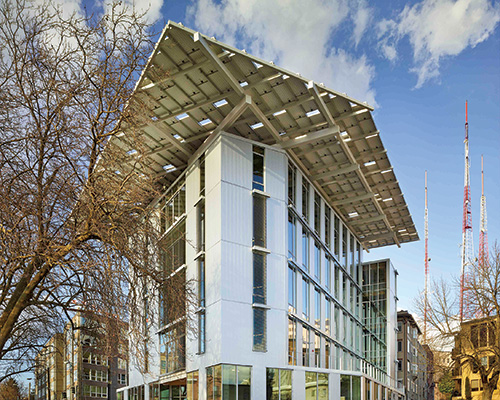
Seattle’s Living Building Pilot Program, a 2009 city ordinance created to remove regulatory and other impediments to the development of ultra-green buildings, would likely never have seen the light of day if not for Denis Hayes, president and CEO of the nonprofit Bullitt Foundation.
Hayes inspired the Seattle program, while developing the conservation group’s two-year-old Bullitt Center, recently certified as a Living Building under the International Living Future Institute’s rigorous Living Building Challenge. The 52,000-sq-ft office building, which houses the foundation and its seven tenants, is considered the world’s greenest building.
Perhaps the most groundbreaking initiative enabled by the pilot is Seattle City Light’s Metered Energy Efficiency Transaction Structure. MEETS is designed to commoditize energy-efficiency investments and make deep energy cuts in commercial buildings economically feasible.
The program separates the energy-efficiency investor from the owner, just as the wind farm developer is separated from the rancher whose property has the turbines. Hayes figures that the program can result in a slash of energy use in most existing buildings by more than 40%. “This could be a trillion-dollar game changer” if utilities across the U.S. adopt Seattle’s MEETS model, says Hayes.
Under MEETS, the utility contracts with an investor—not necessarily the building’s owner or developer—to profitably make energy-efficiency upgrades, based on metered energy savings.
The program, the brainchild of Hayes and Jorge Carrasco—then the utility’s general manager—lets an investor purchase metered energy-efficiency savings over a 20-year term. Based on formulas, savings are literally measured by a meter that allows them to be sold as they occur. The meter was developed by EnergyRM, with support from Portland-based sustainability nonprofit Oregon BEST and the nonprofit Northwest Energy Efficiency Alliance.
By agreeing to pay an incentive for energy saved, Seattle City Light reduces its investment costs for new power generation and creates a revenue stream that could attract investors to finance energy retrofits or more Living Buildings.
“Denis is an innovator who cares deeply about the environment and about our responsibility to protect it for future generations,” says Carrasco, who retired in May. “He finds creative ways to make investments in the environment work for diverse stakeholders,” he adds.
Seattle is going to be looking at 12 projects under its green building initiatives before it makes permanent zoning changes. “People are asking questions, which is what we wanted,” says Diane Sugimura, director of Seattle’s Dept. of Planning and Development.


Post a comment to this article
Report Abusive Comment